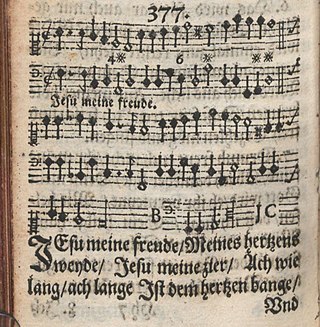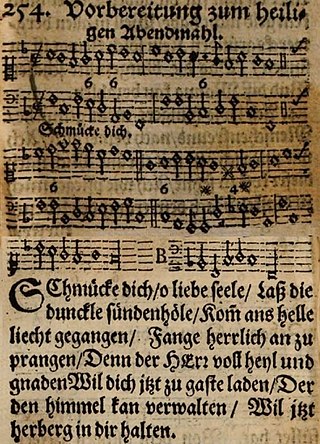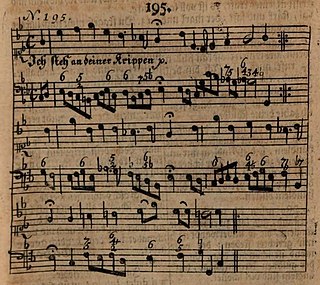The Bach-Werke-Verzeichnis is a catalogue of compositions by Johann Sebastian Bach. It was first published in 1950, edited by Wolfgang Schmieder. The catalogue's second edition appeared in 1990. An abbreviated version of that second edition, known as BWV2a, was published in 1998.

Dame Julia Myra Hess, was an English pianist best known for her performances of the works of Bach, Mozart, Beethoven, Schumann, and Brahms.
Throughout his life as a musician, Johann Sebastian Bach composed cantatas for both secular and sacred use. His church cantatas are cantatas which he composed for use in the Lutheran church, mainly intended for the occasions of the liturgical year.

Johann Sebastian Bach composed the church cantata Herz und Mund und Tat und Leben, BWV 147 in 1723 during his first year as Thomaskantor, the director of church music in Leipzig. His cantata is part of his first cantata cycle there and was written for the Marian feast of the Visitation on 2 July, which commemorates Mary's visit to Elizabeth as narrated in the Gospel of Luke in the prescribed reading for the feast day. Bach based the music on his earlier cantata BWV 147a, written originally in Weimar in 1716 for Advent. He expanded the Advent cantata in six movements to ten movements in two parts in the new work. While the text of the Advent cantata was written by the Weimar court poet Salomo Franck, the librettist of the adapted version who added several recitatives is anonymous.

Johann Schop was a German violinist and composer, [pronounced S-Chop], much admired as a musician and a technician, who was a virtuoso and whose compositions for the violin set impressive technical demands for that area at that time. In 1756 Leopold Mozart commented on the difficulty of a trill in a work by Schop, probably composed before 1646.

Johann Sebastian Bach composed the church cantata Ich armer Mensch, ich Sündenknecht, BWV 55, in Leipzig for the 22nd Sunday after Trinity and first performed it on 17 November 1726.

Mein liebster Jesus ist verloren, BWV 154, is a church cantata by Johann Sebastian Bach. He composed it for the first Sunday after Epiphany and first performed it in Leipzig on 9 January 1724.

Herz und Mund und Tat und Leben, BWV 147.1, BWV 147a, is a cantata by Johann Sebastian Bach. He composed it in Weimar in 1716 for the fourth Sunday in Advent, 20 December. It is uncertain if the work was performed then. He later expanded the work in 1723 as Herz und Mund und Tat und Leben, BWV 147.

"Jesu, meine Freude" is a hymn in German, written by Johann Franck in 1650, with a melody, Zahn No. 8032, by Johann Crüger. The song first appeared in Crüger's hymnal Praxis pietatis melica in 1653. The text addresses Jesus as joy and support, versus enemies and the vanity of existence. The poetry is bar form, with irregular lines from 5 to 8 syllables. The melody repeats the first line as the last, framing each of the six stanzas.
"Herzlich tut mich verlangen" is a German hymn, with lyrics written in 1599 by Christoph Knoll, with a melody adapted from a secular song by Hans Leo Hassler. It is a prayer for a blessed death, beginning "Herzlich tut mich verlangen nach einem sel'gen End". Its hymn tune, Zahn No. 5385a, was later also used for Paul Gerhardt's "Befiehl du deine Wege" and "O Haupt voll Blut und Wunden".
"Werde munter, mein Gemüte" is a Lutheran evening hymn by Johann Rist in twelve stanzas of eight lines each, printed in 1642. The hymn was translated to English and appeared in 67 hymnals.

"Schmücke dich, o liebe Seele" is a Lutheran hymn in German, with lyrics by Johann Franck and a hymn tune by Johann Crüger. It was first published in Crüger's 1649 Geistliche Kirchen-Melodien, and was later adopted in other hymnals, such as the 1653 edition of his Praxis pietatis melica.
Martin Janus was a German Protestant minister, church musician, hymnwriter, teacher and editor. He wrote the lyrics of the hymn "Jesu, meiner Seelen Wonne", which became popular in the arrangement of a Bach chorale as Jesu, Joy of Man's Desiring.

"Ich steh an deiner Krippen hier" is a German Christmas hymn, with lyrics by Paul Gerhardt which were first published in 1653. It was then sung with an older melody by Martin Luther, but a melody which was likely created by Johann Sebastian Bach for Schemellis Gesangbuch of 1736 is now part of current Protestant and Catholic hymnals.
Jesu, meines Glaubens Zier is a German Lutheran hymn by Gottfried Wilhelm Sacer, first published in 1661. Its hymn tune, Zahn No. 6453, was first published in 1714, in Freylinghausen's hymnal. In 1736 the hymn was adopted in Schemellis Gesangbuch, with a figured bass accompaniment which may have been contributed by Johann Sebastian Bach (BWV 472).










